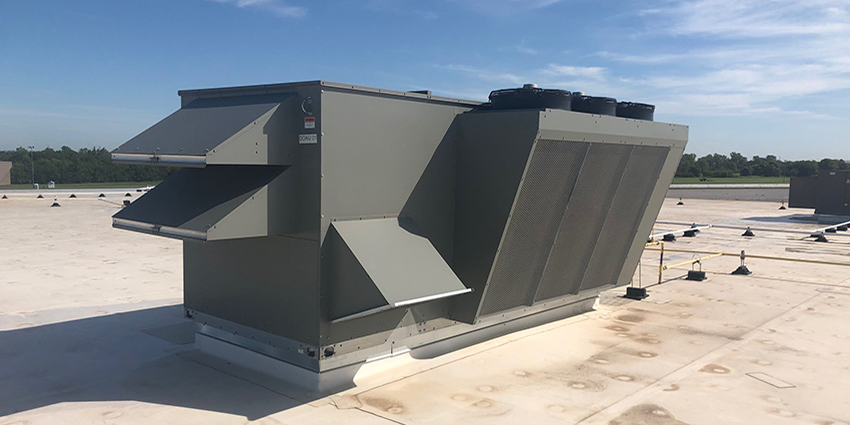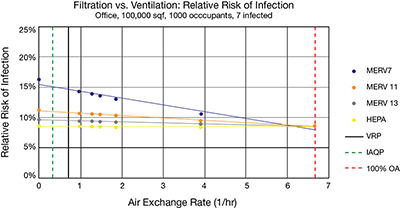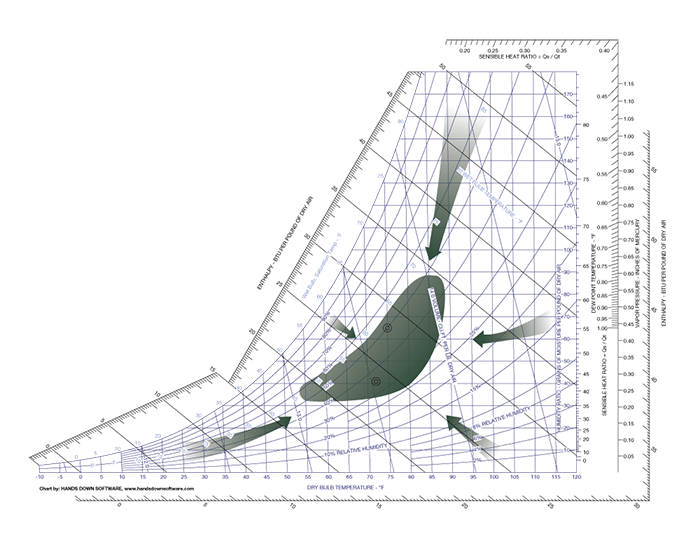
Keeping people safe and protected from contagious viruses has reached unprecedented levels over the past few months. Leading organizations such as the Center for Disease Control (CDC) and medical professionals stress the need for common sense practices to slow the spread of COVID-19 and other contagious viruses.
But, what about your building? Are you doing everything within that space to protect occupants from becoming infected? Here are five tactics to help keep occupants safer and healthier.
Increase Outdoor Ventilation Rates
HVAC systems in non-residential buildings frequently rely on outdoor air to freshen the conditioned air within the building. The amounts vary depending on a variety of circumstances relating to energy usage, environmental conditions and climate. Outdoor air helps disperse and dilute indoor contaminants including virus particles. Increasing the amount of outdoor air coming in through the HVAC system can decrease infection rates. According to energy wheel manufacturer, Airxchange, it is possible to cut infection rates in half, simply by doubling the amount of outdoor ventilation. Therefore, maximizing the amount of outdoor air will minimize the spread of contagious diseases such as the flu and COVID-19 in a building.
The question then is how to add more outside air. The following options allow for more outside air with little difficulty.
- Disable the demand control ventilation. Its use under normal conditions allows a building to supply the proper amount of ventilation based on occupancy. Fewer people usually translates into less ventilation. However, the goal of minimizing virus spread by providing more outdoor air is regardless of occupancy.
- Consider running the HVAC system longer, including seven days a week and 24 hours a day. Doing so disperses virus particles.
- Implement a pre- and post-occupancy flush sequence. If 24/7 operation is not feasible, flushing the space with the peak outdoor air rate before and after occupancy can disperse virus particles while minimizing energy usage. ASHRAE recommends flush periods of 2 hours for both pre- and post-occupancy for systems that meet minimum ventilation requirements.
- Open dampers on partial recirculation units more, up to the maximum 100%. However, make sure the cooling and heating capacity is sized appropriately to handle the additional load.
Increasing ventilation will reduce the concentration of harmful particles in the building. Still, doing so could affect indoor air quality. Warmer air, cooler air, or humid air all requires more conditioning. The outdoor air may contain other pollutants that also affect indoor air.
Increase Filtration Efficiency
Increasing ventilation and introducing more intense filtration dilutes contaminants. Few people would object to increasing ventilation in rural areas. Doing so in metropolitan areas where outdoor air contains significantly higher amounts of pollutants may not be as popular. While increasing ventilation is beneficial, it is equally critical to ensure that desired space conditions are maintained.
Drawing more outdoor air from areas with higher pollution concentration can add to poor indoor air quality and eventually lead to significant challenges such as sick building syndrome. Occupants of buildings with this condition often experience issues including coughs, headaches and respiratory. Sick building syndrome can exacerbate the spread of contagions, such as the COVID-19 virus and others.
 |
| Figure 1 - The type of filter used in a ventilation system affects the spread of contagious viruses. (Source-Engineered Systems magazine) |
Improved filtering of the air can minimize the impact of polluted outdoor air while diluting contaminants in the space. Use a filter with a minimum efficiency reporting value, or MERV of 13, addresses polluted outdoor air and virus particles. Figure 1 compares the effectiveness of various filters at reducing the risk of infection. A higher MERV rating lowers the risk of infection. A MERV-13 air filter captures most harmful particles; however, specialized buildings such as medical facilities may require filters with higher MERV values.
The one significant drawback to increasing filtration is the ability of the equipment to handle the increased static pressure. Therefore, make sure the blowers on your HVAC equipment can handle the elevated static pressure.
Maintain Space Conditions
Research has revealed that certain conditions in the building space can limit the spread of COVID-19 and other contagious viruses. Maintain normal space temperatures and unit operating temperatures when increasing outdoor ventilation. Keep the space humidity levels between 40% and 60% relative humidity, as many microorganisms including most viruses cannot survive in this humidity range.
Creating those conditions however, can be a challenge for many climates. Excessive cold, heat and humidity all can cause problems for maintaining desired space conditions.
Use Energy Recovery
It may seem counterintuitive to use energy recovery when attempting to minimize the spread of harmful viruses. Yet, energy recovery helps reduce cooling and heating modulation by adjusting incoming outdoor air temperatures towards a predictable range.
 |
| Figure 2 - Energy recovery reduces the variability of entering air conditions. All entering air conditions are driven towards a predictable and centralized range (as shown in the solid green). |
Energy recovery products such as the energy wheel and energy core are essential for maintaining desired space conditions. These should remain operational. Energy recovery reduces the variability of air conditions that enter the cooling and heating systems, as shown in Figure 2. A predictable range of entering conditions allows the cooling and heating to be downsized while still meeting load requirements and maintaining acceptable indoor conditions. Disabling or bypassing the energy recovery unit can result in uncontrollable indoor humidity and increase the potential spread of viruses like COVID-19. It is true that there is cross-leakage with energy recovery products. However, the cross-leakage is minimal and does not increase the potential for spread of virus particles. Furthermore, when compared to an air-handling unit running 100% recirculated air; energy recovery products have a significantly lower risk of reintroducing virus particles back into the building.
Options do exist should you still feel uncomfortable with the potential of reintroducing virus particles into the building. It is possible to reduce cross-leakage on energy wheels and energy cores further by increasing the pressure in the supply airstream and decreasing the pressure in the exhaust airstream. ASHRAE recommends that supply pressure should be at least 0.5” higher than the exhaust pressure. You can also disinfect some energy recovery products. For example, a three percent hydrogen peroxide mixture used on an Airxchange wheel will disinfect and kill virus particles.
Consider Supplemental Electronic Air Cleaners
Electronic air cleaning devices can supplement HVAC systems to clean indoor air further and help minimize the spread of COVID-19. Several types of electronic air cleaners exist in the market, including UV-C lights, bipolar ionization, photocatalytic oxidation, electronic air filters, and gas-phase air cleaners. These cleaning technologies have advantages as well as design considerations and can be applied in a variety of ways. Consult with manufacturer-specific manuals and data for more information on the usage and effectiveness of these devices.
Final Thoughts
It is apparent that COVID-19 will be with us for the near-term future. Seasonal flu and other viruses also will again make news as fall and winter approach. Therefore, it is important to do everything we can to minimize the impact. Adjusting building systems to improve indoor air quality and minimize virus transmission between people will help. The five different actions outlined in this blog are simple ways to optimize your HVAC equipment. Learn more about available HVAC solutions.
Sources:
- https://www.epa.gov/sites/production/files/2014-08/documents/sick_building_factsheet.pdf
- “Energy Recovery Best Practices During a Pandemic”
- ASHRAE COVID-19 Frequently Asked Questions
- “Guidance for Building Operations During the COVID-19 Pandemic”


from